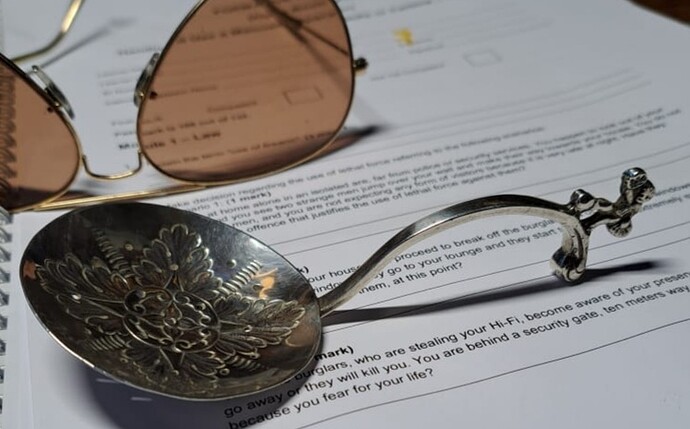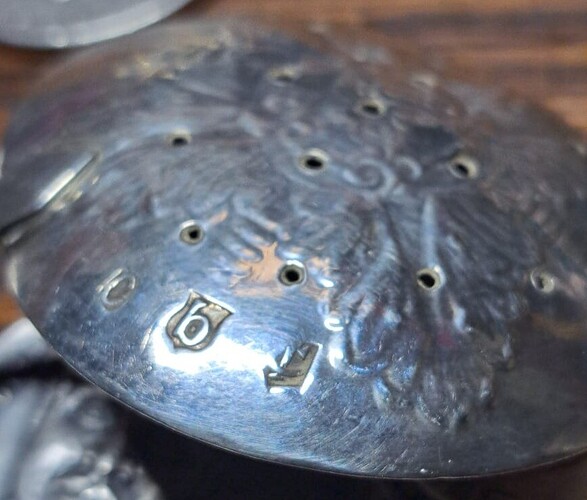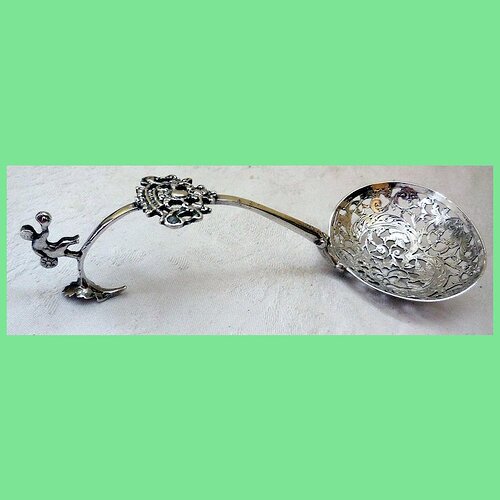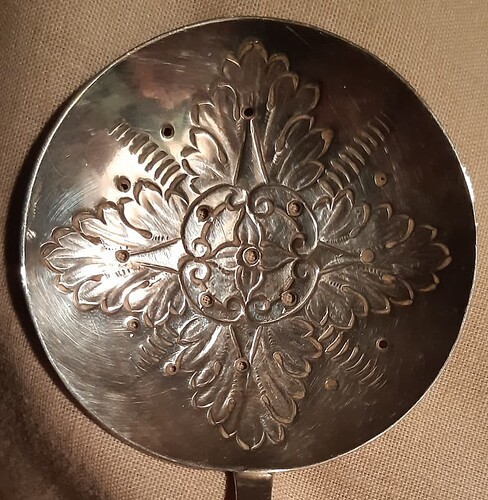Good morning to you all! A friend offered me this spoon to buy. I think it is a kind of mote spoon, probably a sugar sifter. But it has only three marks: a “C”, a date letter and one other mark, unknown to me. I attach four pictures, the best I could obtain. Perhaps you could guide my as to the meaning of these marks on this interesting spoon. Perhaps the ‘knop’ may be of significance, it seems to be cherub-like. A baby? The curve at the end of the handle might be to prevent it from sliding into a dish. I’m thinking it might not be English? Please advise, and thank you!
Regards
Jan
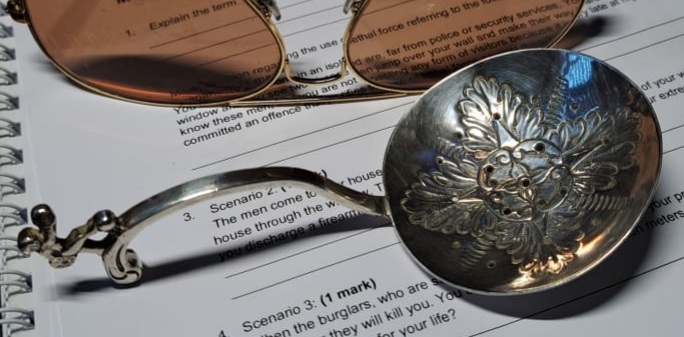
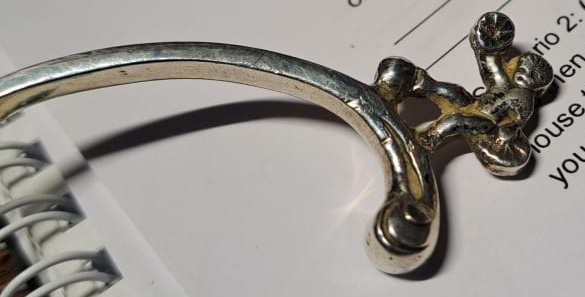
These are not British marks so the “b” is probably not a date letter. I was wondering about Hanau but I can’t find these marks in any of the online Hanau references. It certainly looks European continental but without an obvious fineness or national mark I cannot pin it down any further.
Phil
Thanks so far, Phil. In my scant references I find nothing myself. The right-hand mark looks to me like the top left corner has been polished out. I imagine the symbol might be a “C” with something like a vertical bar through it. Its shield looks like a rectangle with an angled bottom. The left-hand mark seems to be a “C” in a square shield. My little book shows a similar mark to be the city mark for Karlstad (Sweden).
I think the right-hand mark is the pivotal mark to be identified. Are there any more suggestions out there, please?
Regards
Jan
Phil and others, I have been doing some hours of searching on this spoon, which I still assume is a sugar sifter spoon. I have come to think it is a spoon of Dutch make. The clues I have discovered are not very strong, but at least they seem to point to Dutch. Please see the picture I attach, for comparison with my pictures at the top. Please note the strong curve of the stem and the figure at the top of the final bend: a dancing cupid. The description of the picture I attach reads: “Antique Silver BonBon/Sugar Sifter Spoon, Holland. This serving piece is of .833 silver. Along the bowl rim are several marks, which are the Dutch mark for .833 silver, the date stamp for 1912, a tiny key, and “Holland.” The spoon has a decorative reticulated bowl, a mask at the point where the curved handle meets the bowl, a coat of arms part-way up the handle, and a cupid dancing at the top. The spoon measures 6 inches long, and the bowl is 2 3/8 inches wide. The weight is 37.3 grams.”
If my spoon is Dutch, then the mark that looks like a date letter “b” is in fact one, and it indicates 1861.
Do you think this is bringing me closer?
Regards
Jan
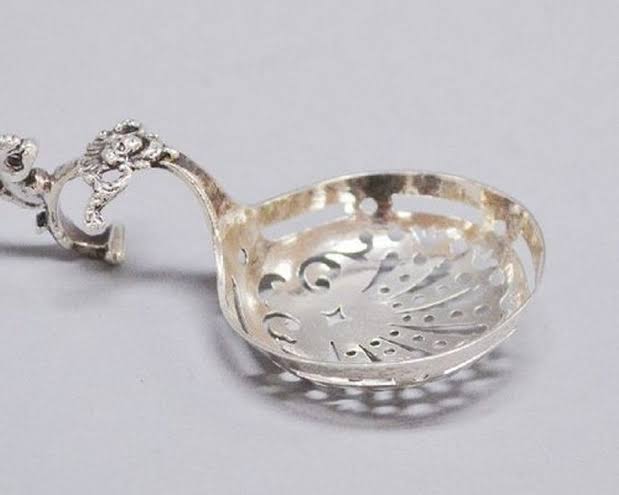
A Dutch origin makes sense as we occasionally see similar spoons with British import marks which are supposed to come from the Netherlands. However I don’t think that the “b” is a Dutch date letter as they all seem to be in circular punches. Sorry to be a bit negative here but I’m at a loss about these marks.
Phil
I believe the Dutch called these monkey spoons as the handle would allow them to hang from the bowl. Am unsure if they were only for sugar or non bond or (when pierced) for sugar. This example is either Dutch, German or with pseudo hallmarks - all widely used in the late 19th century to pre World War I.
Rafer, I thank you for helping to put me on the trail of an adventure! I’ve spent another few hours (thanks to you all) and I’ve got some things worked out, and some other things hanging.
- The spoon is a monkey spoon, all right. That only means it is designed to hang over the edge of some kind of bowl. Some call it a “Mong Kee” spoon.
- All clues I have read up on, point to the original design as being Dutch. Whether my spoon is actually Dutch-made I do not know, but the origin is surely Dutch.
- My spoon’s bowl is perforated, with small round holes. That means it is to be dipped into some liquid, then lifted out with some goodies caught in the bowl and some liquid dripping back out. What would that liquid be? The perforations point to something both liquid and solid, which must be separated.
- The Dutch have an old tradition of serving brandy on special occasions. The brandy is made with sultanas, so this spoon is made to scoop out the sultanas. I’m thinking this spoon would work well doing just that!
- The figure on the finial is sometimes called a “dancing cupid”, also a “dancing amor”, and even a “weigher of souls” (a Roman Catholic concept wherein the Angel Michael is presumed to be at the deathbed). This figure is very often seen. It’s holding some object in each hand, which I cannot identify.
- I suppose a spoon such as this can also serve as a sugar sifter.
- Whether my spoon ever ventured anywhere near the banks of the Hudson River in the 17th or 18th century, will never be known.
(I’m expecting my spoon by courier soon!)
Regards
Jan
Friends, to wrap up this thread, let me say that I received my monkey spoon by courier today (see pic of the inside of the bowl). The bowl is 5.7 cm wide, and the length of the spoon is 12.4 cm. The bowl depicts some kind of flower, I think, surrounded by four leaves, or are they petals, I don’t know.
The best write-up that I have found about these spoons, says: The term “monkey spoon” has been applied to a very unusual folk art style spoon. It is believed that these spoons were primarily used by the Dutch settlers of the New York/Hudson river area and in the Netherlands. The spoon design appears to have come from the Netherland’s province of Friesland and probably from Leeuwarden. In that area they are generically called ‘cream spoons’ if not perforated. These spoons were made from the mid 1700’s to 1900 and were made in various countries by immigrant silversmiths. The primary use of these spoons was in the serving of a popular rum and raisin toddy. The Dutch have been known to be heavy drinkers and the American Dutch dominated the rum trade between New York, the Caribbean Islands and Europe. The pierced bowl spoons were for the serving of the raisins without the rum. In the Groningen province in the north of the Netherlands there is a specialty called “Boerejongens”, consisting of brandy, sultanas and spices. Boerejongens is often enjoyed as a drink in a glass, with a spoon to scoop out the brandy-soaked sultanas. It’s the same as rum-and-raisins!
All of these spoons have a hook and could hang from a bowl edge. All of these spoons are hand-made. They are not the product of a factory and many have an unsophisticated quality (like mine, I think).
Most of them are made from 800 or better quality silver (I had mine scanned by XRF today and the result was “sterling”). These spoons are composed of three parts: a large bowl, a boss on the handle and a finial emblem soldered to the curved part of the handle. The bowls vary in size and shape and orientation.
Thanks to all who have encouraged me to look all this stuff up. Please do comment if you think I might have missed something!
Regards, Jan
Certainly a cool looking spoon. Sorry no help from me. But I was trying to figure out your who dun-nit mystery literature under the spoon 
Ja, KrisKat, if I don’t provide an explanation for your query, it will bother you for ever, not?  My cousin in another city is applying for a new firearm license, and he has to undergo training in the responsible use of a firearm, in order to get a competency certificate, otherwise his application cannot go through. The pic was taken on the table where the open instruction manual was lying.
My cousin in another city is applying for a new firearm license, and he has to undergo training in the responsible use of a firearm, in order to get a competency certificate, otherwise his application cannot go through. The pic was taken on the table where the open instruction manual was lying.
Back to topic: I think I have all the info on the monkey spoon that I can expect to get. The pseudo hallmarks will probably never be explained, as I believe they were put on just for show. But the spoon is very surely Dutch. I just wish I could pin it down as to year of manufacture…
Regards
Jan
